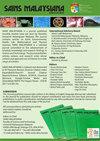利用直接电沉积和脉冲电沉积技术,从简单的硫酸铜溶液中获得具有改善附着力的FTO上的铜纳米颗粒涂层
IF 0.7
4区 综合性期刊
Q3 MULTIDISCIPLINARY SCIENCES
引用次数: 0
摘要
采用电沉积法在FTO玻璃表面沉积了铜纳米颗粒。前驱体为CuSO4×5H2O,无机添加剂为Na2SO4。利用场发射扫描电镜(FESEM)、能量色散x射线能谱(EDX)和x射线衍射(XRD)对Cu的形成进行了表征。本研究考察了电沉积方法(直接电沉积vs脉冲电沉积)、电压(- 0.4 V和- 0.8 V)、电沉积时间(60 ~ 900s)和脉冲周期(50 ~ 300周期)以及FTO蚀刻(固定到20s蚀刻)对Cu镀层形貌和附着力的影响。沉积铜的晶粒尺寸和厚度随沉积时间和脉冲周期的变化而变化。-0.4 V的电压成功地在FTO玻璃上沉积了有光泽的棕色金属铜。同时,-0.8 V的电压使铜表面呈粉状棕色。此外,与直接电沉积(DD)相比,脉冲电沉积(PD)在FTO玻璃上提供了更紧凑和均匀的Cu覆盖层。胶带测试结果还表明,电解还原的FTO蚀刻可以提高沉积的Cu薄膜与FTO玻璃之间的粘附强度。这项工作证明了一种简单的电沉积技术与衬底蚀刻作为铜金属的有效沉积,具有广泛应用领域的潜力。本文章由计算机程序翻译,如有差异,请以英文原文为准。
Copper Nanoparticles Coating on FTO with Improved Adhesion Using Direct and Pulse Electrodeposition Techniques from a Simple Copper Sulphate Solution
Copper (Cu) metal nanoparticles were deposited onto FTO glass using the electrodeposition method. The precursor used was CuSO4×5H2O with Na2SO4 as the inorganic additive. The formation of Cu was characterized using field emission scanning electron microscopy (FESEM), energy-dispersive X-ray spectroscopy (EDX), and X-ray diffraction (XRD). This study investigated the impacts of the electrodeposition method (direct electrodeposition vs. pulse electrodeposition), voltages (‑0.4 V and ‑0.8 V), electrodeposition time (60s to 900s) and pulse cycles (50 cycles to 300 cycles), and FTO etching (fixed to 20s etching) towards the morphology and adhesion of Cu deposited. The grain size and thickness of Cu deposited vary with deposition time and pulse cycles. The voltage of -0.4 V successfully deposits shiny, metallic brown Cu onto FTO glass. Meanwhile, the voltage of -0.8 V gives powdery brown Cu on the surface. In addition, compared to direct electrodeposition (DD), pulse electrodeposition (PD) provides a more compact and homogeneous coverage of Cu onto FTO glass. The tape-test results also indicate that FTO etching by electrolysis reduction can improve the adhesion strength between deposited thin Cu film and the FTO glass. This work demonstrates a facile electrodeposition technique with substrate etching as an effective deposition of Cu metal with the potential for application in a wide range of fields.
求助全文
通过发布文献求助,成功后即可免费获取论文全文。
去求助
来源期刊

Sains Malaysiana
MULTIDISCIPLINARY SCIENCES-
CiteScore
1.60
自引率
12.50%
发文量
196
审稿时长
3-6 weeks
期刊介绍:
Sains Malaysiana is a refereed journal committed to the advancement of scholarly knowledge and research findings of the several branches of science and technology. It contains articles on Earth Sciences, Health Sciences, Life Sciences, Mathematical Sciences and Physical Sciences. The journal publishes articles, reviews, and research notes whose content and approach are of interest to a wide range of scholars. Sains Malaysiana is published by the UKM Press an its autonomous Editorial Board are drawn from the Faculty of Science and Technology, Universiti Kebangsaan Malaysia. In addition, distinguished scholars from local and foreign universities are appointed to serve as advisory board members and referees.
 求助内容:
求助内容: 应助结果提醒方式:
应助结果提醒方式:


